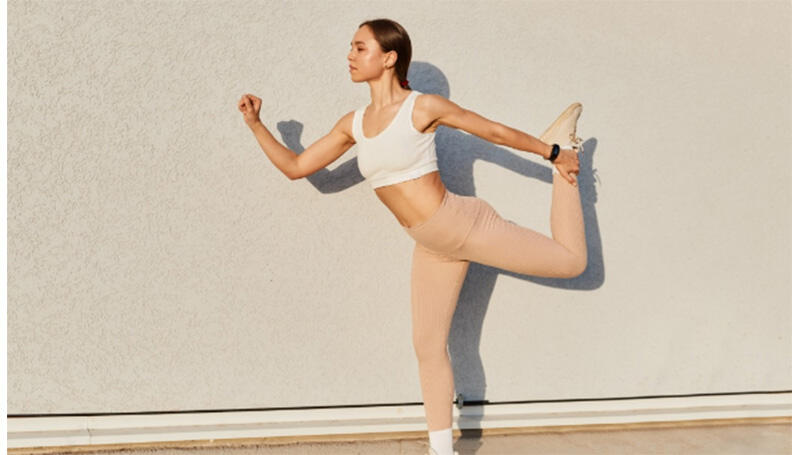A práctica do yoga tamén gañou popularidade a nivel mundial e, à medida que a competición aumenta entre os practicantes, tamén aumenta o número de estilos diferentes de ropa de yoga. Por tanto, o tecido empregado na fabricación da roupa pode ter un efecto na comodidade, o rendemento e a experiencia en xeral. Este artigo analizará varios tecidos e verá como as calzas de yoga poden diferir nas prácticas.
A Importancia do Tecido na Ropa para Yoga
Nunha clase de yoga típica, a ropa utilizada pode afectar o rendemento global da persoa e incluso o seu nivel de comodidade. Un bo tecido ten o material adecuado que permite o movemento, controla eficientemente o sudor e seca rapidamente, o que axuda a que a persoa se concentre e disfrute durante toda a sesión. Isto é importante, xa que permítelle entender como funcionan diferentes materiais para a próxima vez que teña intención de comprar ropa de yoga.
Algodón: Respirabilidade e Comodidade
O algodón probablemente sexa un dos materiais máis utilizados na ropa de yoga. O algodón é coñecido por ser moi suave e permitir que a pelle respire, polo que é unha fibra natural para vestir. nunha sesión de exercicio, é moi crucial ter boa circulación de aire para minimizar as posibilidades de sobreaquecemento.
Non obstante, o algodón tamén ten as súas desvantaxes. Non absorbe moi ben a humidade e, ás veces, pode deixarte moito e pesado despois dunha sesión de exercicio na gimnasia. Ademais, xa que o algodón ten unha elasticidade débil, pode enrugar e perder a súa elasticidade co tempo, o que o fai non adecuado para exercicios intensos.
Materiais Sintéticos: Resistentes e Eliminan o Sudor
O nilón, o elastano, o poliéster e outros materiais sintéticos foron ganando popularidade na categoría de dispositivos fitness portábeis. Estes tecidos son coñecidos pola súa durabilidade, elasticidade e capacidade de eliminar a humidade do corpo. Funcionan moi ben para manter o sudor lonxe do teu corpo, facéndote sentir cómodo incluso en entrenamentos acalorados.
Por exemplo, o poliéster é moi resistente e non se encolexe ou arruga facilmente, mentres que a nilón é moi suave e sedosa pero tamén moi forte. O spandex, coñecido tamén como elastano, é un tejido moi elástico e úsase en roupa de yoga porque permite movementos complexos sen romperse facilmente.
Infelizmente, o maior inconveniente destes materiais sintéticos é que tenden a ser menos transpirables que as fibras naturais. Algúns xente tamén poderán desenvolver irritacións na pele, xa que algúns tipos de pele son sensibles aos químicos con que están fabricados. De calquera forma, sempre están aparecendo novas tecnoloxías de tecidos para crear as mellores fibras sintéticas que funcionan como as naturais pero con unha maior rendemento.
Bambú: De Alta Resistencia, Antibacteriano e Seguro Para o Medio Ambiente
Recentemente, a popularidade do tecido de bambú como un dos materiais máis respetuosos coa natureza para a ropa de yoga está en aumento. Por exemplo, xa se demostrou que a maioría dos produtos de bambú poden ser reciclados, xa que é unha planta que cre moi rápido e non dana ao noso medio ambiente tanto como o algodón tradicional ou os textis de polímeros. Ademais, os tecidos de bambú son moi suaves, transpirables e non irritantes.
O tecido de bambú ten varias propiedades importantes, entre as que se inclúe actividade antibacteriana real e control de olores. Polo tanto, é unha boa elección para os yoguis entusiastas e para climas calurosos e húmidos. Ademais, o bambú tamén é un bo material absorbente, xa que pode axudar a eliminar a humedad e manerte seco mentres practicas.
Non obstante, os tecidos de bambú teñen un prezo, que é máis elevado en comparación co algodón ou os sintéticos, e incluso niso pode haber uso de químicos que eliminan o factor ecolóxico. Así que, é imperativo buscar e escoller empresas que o fagan.
Lana Merino: Adaptabilidade e suave tacto a temperatura da habitación
No mundo das fibras, destaca pola súa capacidade de rexulación da temperatura. A lana de ovejas Merino é unha das máis finas e suaves, polo que o conforto ao contacto coa pele non é nunca un problema. A lana Merino ten a capacidade única de enteñerche cando está fresco e refrescarte cando fai calor, o que a fai ideal para roupa de yoga.
Ademais do equilibrio de temperatura, a lana Merino é naturalmente desodorizante e antimicrobiana, polo que é adecuada para uso a longo prazo. Tamén ten grandes capacidades de transferencia de humidade, o que te mantén seco mesmo durante os entrenamentos máis intensos.
Entre outros problemas, a lana Merino é cara e debe manusearse con extremo cuidado ao lavar para evitar os riscos de encollemento e dano. Ainda así, moitas persoas pensan que as primeiras vantaxes son en moitos casos máis importantes que as segundas. A lana Merino é especialmente adecuada para clases de yoga ao aire libre ou en tempo frio.
Fibras combinadas: Lo mellor de dous mundos
Os tecidos combinados formánse pola mistura de fibras distintas para permitir que o material aproveite as propiedades beneficiosas de cada un dos seus compoñentes. As combinacións como estas son: algodón-poliestireno, bambú-elástano e nilón-lana. O propósito destas combinacións é lograr comodidade, durabilidade, respirabilidade e control da humidade.
Por exemplo, unha combinación de algodón-poliestireno é suave e permite a respirabilidade do algodón, pero tamén conta coa fortaleza e a capacidade de absorción da humidade do poliestireno. Non é ningunha sorpresa que cada combinación teña a súa propia característica. Así, sería bo empregar unha combinación xa que pode cubrir os teus requisitos e coincidir cos teus gustos.
Conclusión: Fágoo ao Estilo do Yoga – Escollendo Material para a Práctica Yogui
A decisión sobre o material adecuado para a ropa de yoga pode variar en función de cada individuo, do tipo de práctica de yoga e do lugar onde se realice. Sexa apertada ou holgada, que permita o movemento ou apertada para o control da humidade, é necesario que saibas que tipos de materiais precisas para lograr o obxectivo da túa práctica de yoga.
 EN
EN
 AR
AR BG
BG HR
HR CS
CS DA
DA NL
NL FI
FI FR
FR DE
DE EL
EL IT
IT NO
NO PL
PL PT
PT RO
RO RU
RU ES
ES SV
SV CA
CA TL
TL ID
ID LV
LV LT
LT SR
SR SK
SK UK
UK SQ
SQ ET
ET GL
GL HU
HU TR
TR FA
FA MS
MS GA
GA CY
CY IS
IS KA
KA
